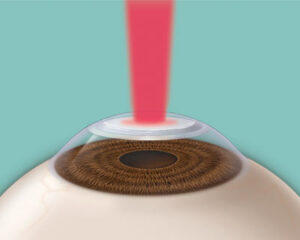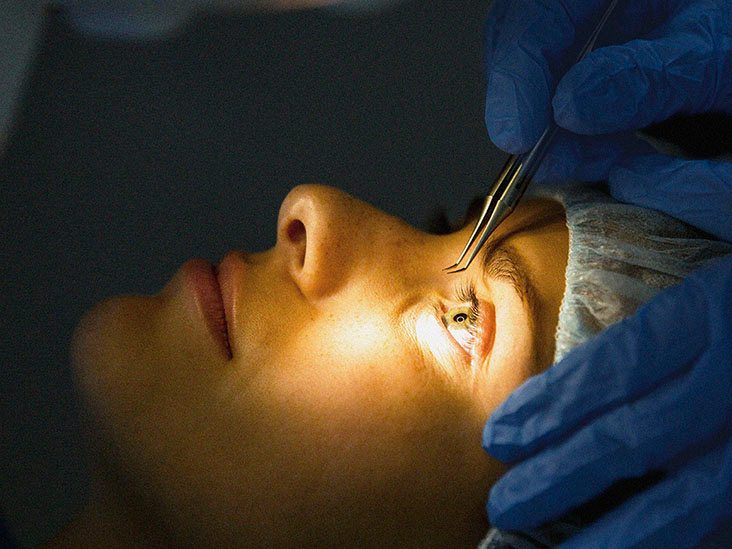PRK surgery is a great option for people who want to improve their vision without having to go through the hassle of LASIK surgery. However, as with any type of surgery, there are some risks involved. In this blog post, we will discuss some of the most common complications that may occur after PRK surgery. If you are considering this type of surgery, it is important to be aware of these potential problems so that you can make an informed decision.
Contents
What Is PRK Surgery?
 PRK surgery is a type of refractive surgery that is used to improve vision. The surgeon uses a laser to remove tissue from the cornea, which helps to change its shape and allows light to be focused correctly on the retina.
PRK surgery is a type of refractive surgery that is used to improve vision. The surgeon uses a laser to remove tissue from the cornea, which helps to change its shape and allows light to be focused correctly on the retina.
PRK surgery is different from LASIK surgery in that it does not involve creating a flap in the cornea. Because of this, PRK surgery generally has a shorter recovery time than LASIK surgery.
PRK surgery is typically safe and effective, but as with any type of surgery, there are some potential risks and complications that you should be aware of. So here we are going to discuss some common PRK surgery complications and what you can do about them.
What Are Some PRK Surgery Complications?
As with any type of surgery, PRK surgery comes with a risk of complications. Some common PRK surgery complications include:
Infection
One of the most serious potential complications of any type of eye surgery is infection. While the risk of infection after PRK surgery is relatively low, it is still a possibility. Signs of infection may include redness, pain, discharge, and light sensitivity. If you experience any of these symptoms, it is important to contact your doctor right away.
Refractive Error
Another potential complication of PRK surgery is that your vision may not be corrected as much as you had hoped. In some cases, you may even develop a refractive error, which is when your eyesight is actually worse after surgery than it was before.
Dry Eyes
It is not uncommon for patients to experience dry eyes after PRK surgery. This is because the cornea is no longer able to produce tears as efficiently as it did before. Dry eyes can be a nuisance, but they usually improve within a few months.
Corneal Scarring
In some cases, the surface of the eye may become scarred after PRK surgery. This can occur if the eye is not properly protected from UV light exposure during the healing process, or if an infection develops. Corneal scarring can lead to vision problems and may require additional surgery to correct.
Double vision
Many times after the PRK surgery, patients report that they see two images instead of one. This condition is called diplopia, and it usually goes away on its own after a few weeks or months. However, in some cases, it may be permanent.
Corneal haze
This is a cloudy area that can develop in the center of your cornea. It usually goes away on its own within several months, but in some cases, it may persist. This complication is more common in people who have high myopia. However, it can occur in anyone who has PRK surgery.
So, these are some common complications that may occur after PRK surgery. While they are usually minor and temporary, it’s important to be aware of them so you can seek treatment if necessary. If you experience any severe symptoms or problems after your surgery, be sure to contact your doctor right away.
How Common Are PRK Surgery Complications?
 While PRK surgery is generally considered safe, as with any type of surgery, there are always potential risks and complications that can occur. The good news is that serious complications from PRK surgery are quite rare, occurring in less than 1% of all cases.
While PRK surgery is generally considered safe, as with any type of surgery, there are always potential risks and complications that can occur. The good news is that serious complications from PRK surgery are quite rare, occurring in less than 1% of all cases.
More often, it is believed that temporary side effects and minor complications are much more likely after surgery. In fact, according to one study, nearly 50% of all PRK patients experience some type of complication in the first three months following their procedure.
Therefore, it’s important to be aware of the potential risks and complications that can occur after PRK surgery, so you can be prepared for what to expect.
How To Manage These Complications?
Even though PRK surgery is considered to be a very safe and effective procedure, there are still some potential complications that can occur. It’s important to be aware of these so that you can know what to expect and how to manage them if they do occur.
Here are some of the tips to manage these complications:
- Follow post-operation instructions: Be sure to follow all of your eye doctor’s post-operation instructions. This will help to ensure that your eyes heal properly and reduce the risk of complications.
- Use artificial tears: If you experience dryness or irritation, be sure to use artificial tears as often as needed. This will help to lubricate your eyes and prevent further irritation.
- Take breaks from screen time: If you spend a lot of time looking at screens, it’s important to take breaks often. This will help to reduce eye strain and prevent further irritation.
- Avoid rubbing your eyes: It’s important to avoid rubbing your eyes, as this can cause further irritation or even lead to an infection. If you must rub your eyes, be sure to do so gently and with clean hands.
- Quit smoking: Smoking can increase the risk of complications after any surgery. If you smoke, it’s important to quit before and after your PRK surgery.
- Eat healthily: Eating a healthy diet can help your eyes heal properly after surgery. Be sure to eat plenty of fruits, vegetables, and whole grains.
- See your doctor if symptoms persist: If you experience any persistent symptoms, be sure to see your eye doctor right away. They will be able to determine if there is a more serious problem that needs to be treated.
So these were some of the things that can you do to avoid or manage complications after PRK surgery. Be sure to follow all of your eye doctor’s instructions and take care of your eyes to ensure a successful surgery and recovery. Otherwise, the complications can lead to serious problems. Do not forget to consult with your ophthalmologist if you experience any vision changes, severe pain, discharge, or redness in the eye.
Is PRK Worth The Risk?
 Now, people considering PRK surgery must ask themselves if the risks are worth the benefits of the procedure. The answer is pretty simple and straightforward – it depends on the individual. Some people are willing to take on a higher risk in order to achieve their vision goals, while others would rather err on the side of caution.
Now, people considering PRK surgery must ask themselves if the risks are worth the benefits of the procedure. The answer is pretty simple and straightforward – it depends on the individual. Some people are willing to take on a higher risk in order to achieve their vision goals, while others would rather err on the side of caution.
As with any surgery, there are certain risks and complications associated with PRK. But the benefits of PRK surgery can be life-changing, so it’s important to weigh the pros and cons before making a decision.
However, according to studies, people who have undergone PRK surgery have a very high success rate. In fact, PRK has a success rate of over 95%. This means that out of 100 people who have the surgery, only 5 will experience any sort of complication. And those complications can be minor and easily treatable.
So if you’re considering PRK surgery, don’t let the risks deter you. Yes, there are risks involved, but the vast majority of people who have the surgery experience no complications whatsoever.
Conclusion
To conclude, PRK surgery complications can be numerous and range from mild to severe. While the majority of patients only experience mild symptoms, a small percentage will develop more serious complications that could threaten their vision. If you are considering PRK surgery, be sure to discuss the risks and potential complications with your doctor beforehand.
This way, you can make an informed decision about whether or not the surgery is right for you. And with time, you can be sure that any complications you experience will eventually resolve themselves.
EyeMantra also offers the most advanced Lasik options including PRK, Femto Lasik, SMILE surgery, Standard lasik, and Contoura vision. If you have any questions on lasik surgery, lasik surgery cost and lasik procedure, call us at +91-9711116605 or email at [email protected].


